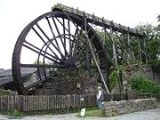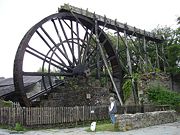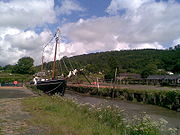
Morwellham Quay
Encyclopedia


Devon
Devon is a large county in southwestern England. The county is sometimes referred to as Devonshire, although the term is rarely used inside the county itself as the county has never been officially "shired", it often indicates a traditional or historical context.The county shares borders with...
, England
England
England is a country that is part of the United Kingdom. It shares land borders with Scotland to the north and Wales to the west; the Irish Sea is to the north west, the Celtic Sea to the south west, with the North Sea to the east and the English Channel to the south separating it from continental...
that developed to support the local mines. The port had its peak in the Victorian era
Victorian era
The Victorian era of British history was the period of Queen Victoria's reign from 20 June 1837 until her death on 22 January 1901. It was a long period of peace, prosperity, refined sensibilities and national self-confidence...
and is now run as a tourist attraction and museum. It is the terminus of the Tavistock Canal
Tavistock Canal
The Tavistock Canal is a canal in the county of Devon in England. It was constructed early in the 19th century to link the town of Tavistock to Morwellham Quay on the River Tamar, where cargo could be loaded into ships...
, and has its own copper
Copper
Copper is a chemical element with the symbol Cu and atomic number 29. It is a ductile metal with very high thermal and electrical conductivity. Pure copper is soft and malleable; an exposed surface has a reddish-orange tarnish...
mine.
The open air museum
Open air museum
An open-air museum is a distinct type of museum exhibiting its collections out-of-doors. The first open-air museums were established in Scandinavia towards the end of the nineteenth century, and the concept soon spread throughout Europe and North America. Open-air museums are variously known as...
includes the restored 19th century village, the docks and quays, a restored ship, the George and Charlotte copper mine which is toured by a small train, a Victorian
Victorian era
The Victorian era of British history was the period of Queen Victoria's reign from 20 June 1837 until her death on 22 January 1901. It was a long period of peace, prosperity, refined sensibilities and national self-confidence...
farm and a nature reserve with trails.
In July 2006, UNESCO (the cultural arm of the United Nations) awarded World Heritage Site status to the Cornwall and West Devon Mining Landscape
Cornwall and West Devon Mining Landscape
The Cornwall and West Devon Mining Landscape is a World Heritage Site which includes select mining landscapes across Cornwall and West Devon in the south west of the United Kingdom...
area. Morwellham is strategically sited at the centre of the Tamar Valley Mining District which, together with nearby Tavistock, forms the easternmost gateway area to the rest of the World Heritage Site
World Heritage Site
A UNESCO World Heritage Site is a place that is listed by the UNESCO as of special cultural or physical significance...
.
The industrial Heritage
Industrial heritage
Industrial heritage is an aspect of cultural heritage dealing specifically with the buildings and artifacts of industry which are inherited from past generations, maintained in the present and bestowed for the benefit of future generations, often forming a significant attraction for tourism.The...
museum is an Anchor Point of ERIH, The European Route of Industrial Heritage
European Route of Industrial Heritage
The European Route of Industrial Heritage is a network of the most important industrial heritage sites in Europe. The aim of the project is to create interest for the common European Heritage of the Industrialisation and its remains...
.
History
Morwellham Quay was originally set up by the BenedictineBenedictine
Benedictine refers to the spirituality and consecrated life in accordance with the Rule of St Benedict, written by Benedict of Nursia in the sixth century for the cenobitic communities he founded in central Italy. The most notable of these is Monte Cassino, the first monastery founded by Benedict...
monks of Tavistock Abbey
Tavistock Abbey
Tavistock Abbey, also known as the Abbey of Saint Mary and Saint Rumon, is a ruined Benedictine abbey in Tavistock, Devon. Nothing remains of the abbey except the refectory, two gateways and a porch. The abbey church, dedicated to Our Lady and St Rumon, was destroyed by Danish raiders in 997 and...
, which was founded in 961, to carry goods to and from Plymouth
Plymouth
Plymouth is a city and unitary authority area on the coast of Devon, England, about south-west of London. It is built between the mouths of the rivers Plym to the east and Tamar to the west, where they join Plymouth Sound...
on the River Tamar
River Tamar
The Tamar is a river in South West England, that forms most of the border between Devon and Cornwall . It is one of several British rivers whose ancient name is assumed to be derived from a prehistoric river word apparently meaning "dark flowing" and which it shares with the River Thames.The...
, since the River Tavy
River Tavy
The Tavy is a river on Dartmoor, Devon, England. The name derives from the Brythonic root "Taff", the original meaning of which has now been lost...
was unnavigable. By the 12th century, tin
Tin
Tin is a chemical element with the symbol Sn and atomic number 50. It is a main group metal in group 14 of the periodic table. Tin shows chemical similarity to both neighboring group 14 elements, germanium and lead and has two possible oxidation states, +2 and the slightly more stable +4...
ore
Ore
An ore is a type of rock that contains minerals with important elements including metals. The ores are extracted through mining; these are then refined to extract the valuable element....
was being transported through the quay, followed by lead
Lead
Lead is a main-group element in the carbon group with the symbol Pb and atomic number 82. Lead is a soft, malleable poor metal. It is also counted as one of the heavy metals. Metallic lead has a bluish-white color after being freshly cut, but it soon tarnishes to a dull grayish color when exposed...
and silver
Silver
Silver is a metallic chemical element with the chemical symbol Ag and atomic number 47. A soft, white, lustrous transition metal, it has the highest electrical conductivity of any element and the highest thermal conductivity of any metal...
ores in the 13th century. Later, copper
Copper
Copper is a chemical element with the symbol Cu and atomic number 29. It is a ductile metal with very high thermal and electrical conductivity. Pure copper is soft and malleable; an exposed surface has a reddish-orange tarnish...
deposits were also discovered at the Quay itself and the George and Charlotte Mine opened in the 18th century. In addition, by 1800, manganese
Manganese
Manganese is a chemical element, designated by the symbol Mn. It has the atomic number 25. It is found as a free element in nature , and in many minerals...
deposits were being extracted from the northern and western edges of Dartmoor
Dartmoor
Dartmoor is an area of moorland in south Devon, England. Protected by National Park status, it covers .The granite upland dates from the Carboniferous period of geological history. The moorland is capped with many exposed granite hilltops known as tors, providing habitats for Dartmoor wildlife. The...
and being brought to Morwellham.
By the end of the 18th century, the trail of pack horses across the rugged terrain was too much, and in 1817 the 4.5 mile long Tavistock Canal
Tavistock Canal
The Tavistock Canal is a canal in the county of Devon in England. It was constructed early in the 19th century to link the town of Tavistock to Morwellham Quay on the River Tamar, where cargo could be loaded into ships...
was opened. The canal included a 1.5 mile tunnel which ended 237 feet above the quay at Morwellham. From here an inclined plane
Canal inclined plane
An inclined plane is a system used on some canals for raising boats between different water levels. Boats may be conveyed afloat, in caissons, or may be carried in cradles or slings. It can be considered as a specialised type of cable railway....
was constructed to bring the iron barges down to the quay, powered by a water wheel.
The heyday for Morwellham Quay came when the largest and richest copper deposits ever were discovered at the Devon Great Consols just 4 miles to the north in 1844. £1 shares were soon worth £800 as the rush to extract the ore started. This gave rise to Morwellham's fame as the "richest Copper port in Queen Victoria's Empire", and the queen herself visited in 1856. Another inclined plane was built to transport the ore down the hill and a new quay was added to handle the 30,000 tons of ore that were exported each year. Arsenic
Arsenic
Arsenic is a chemical element with the symbol As, atomic number 33 and relative atomic mass 74.92. Arsenic occurs in many minerals, usually in conjunction with sulfur and metals, and also as a pure elemental crystal. It was first documented by Albertus Magnus in 1250.Arsenic is a metalloid...
was also extracted and it became the world's largest supplier of the mineral in the latter part of the century. However by 1903 the Consols' wealth was exhausted and the mines closed.
By this stage, the railways had taken over and Morwellham's usefulness was also ended. The canal tunnel was used as a water supply for a hydroelectric plant and the inclined planes were abandoned.
In 2009 Devon County Council
Devon County Council
Devon County Council is the county council administering the English county of Devon. Based in the city of Exeter, the council covers the non-metropolitan county area of Devon...
withdrew funding for the mining museum, which as a direct result was placed into administration. In April 2010 the site was purchased by the owners of Bicton Park, and it reopened to the public later in the year.
Industrial Heritage
The site has been imaginatively preserved to give an impression of Victorian industrial and rural life. The assayers' offices have been carefully preserved and Victorian cottages, farm and schoolrooms presented. The ore crushing plants driven by a 32 foot overhead waterwheel can be seen. A battery electric powered tramway, constructed as part of the tourist attraction in the 1970s, takes visitors for tours on a single level of the copper mine. There is also an extensive ecological programme of visits to explore the valley by water and land. Old lime kilns can also be seen.Edwardian Farm
The BBCBBC
The British Broadcasting Corporation is a British public service broadcaster. Its headquarters is at Broadcasting House in the City of Westminster, London. It is the largest broadcaster in the world, with about 23,000 staff...
television series Edwardian Farm
Edwardian Farm
Edwardian Farm is an historical documentary TV series in twelve parts, first shown on BBC Two from November 2010 to January 2011. It was made for the BBC by independent production company Lion Television and filmed at Morwellham Quay, an historic quay in Devon. The farming team was historian Ruth...
was filmed at Morwellham Quay during 2009/2010.
Further reading
- Booker, Frank (1967) The Industrial Archaeology of the Tamar Valley. Newton Abbot: David & Charles; Revised impression 1971

